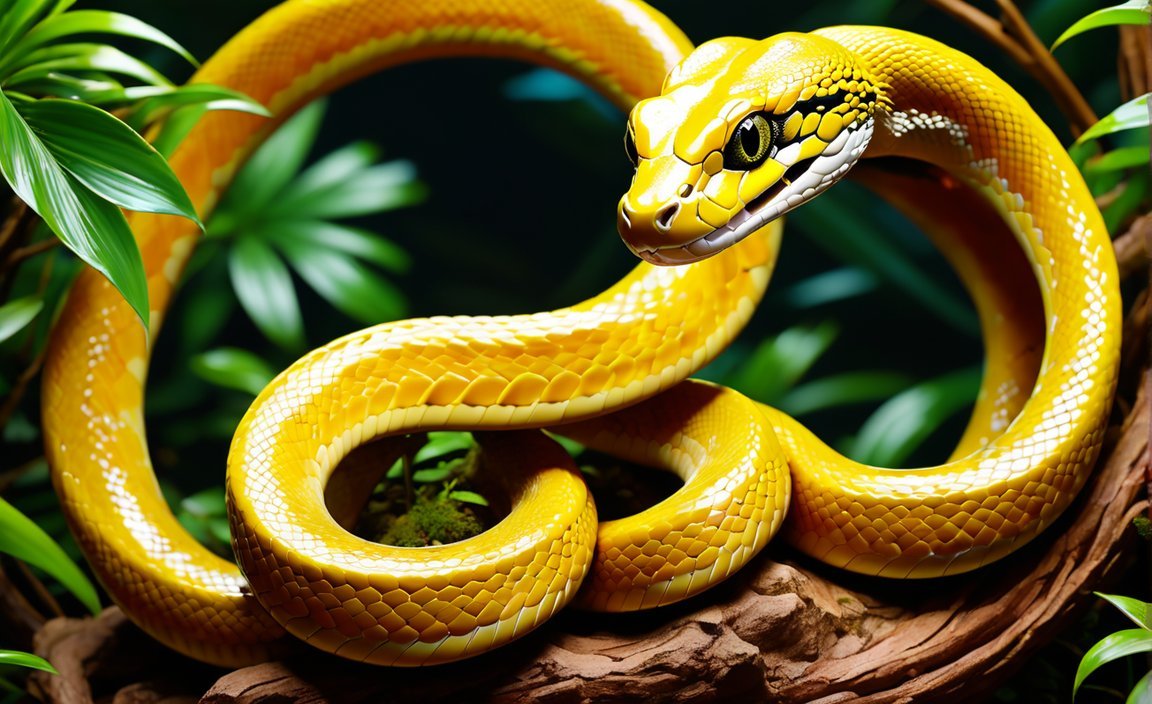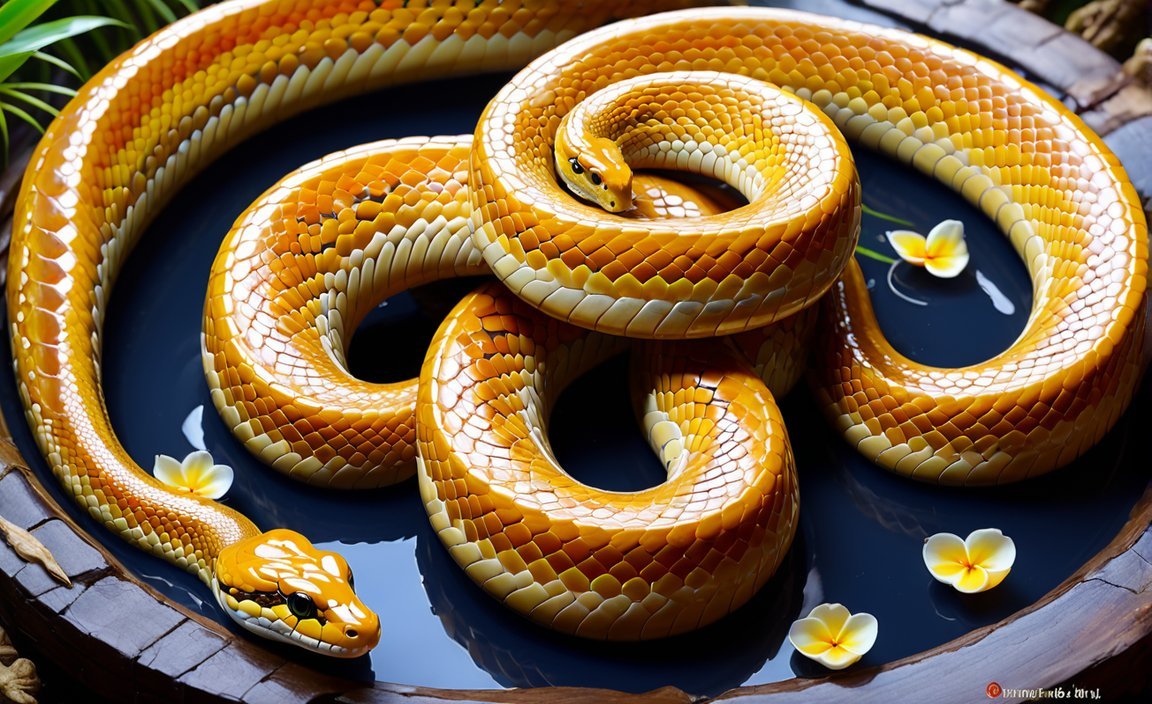The Elusive Nyaminyami Snake: Unveiling the Secrets of a Majestic Reptile

Embarking on a journey to uncover the mysterious world of the Nyaminyami snake, this article delves into the depths of this enigmatic creature’s existence. With its striking appearance and elusive nature, the Nyaminyami snake has intrigued researchers and nature enthusiasts alike for generations. Drawing on a wealth of experience and expertise in herpetology, this exploration aims to shed light on the unique characteristics and significance of this majestic reptile within the intricate ecological web. Through careful observation and scientific analysis, we bring forth a captivating narrative that unveils the hidden secrets of the Nyaminyami snake.
Key Takeaways:
- The Nyami Nyami, also known as the Zambezi River God or Zambezi Snake Spirit, is a significant deity for the Tonga people.
- The Nyami Nyami is believed to protect the Tonga people and provide for them during difficult times.
- It is often depicted as a male god in Tonga mythology.
- The Kariba Dam legend revolves around the Nyami Nyami and the construction of the dam.
- The BaTonga people believed that the Nyami Nyami would prevent the dam from being built.
- The dam project faced setbacks, including floods and worker fatalities.
- The Tonga elders suggested making a sacrifice to appease the Nyami Nyami, resulting in the discovery of the missing workers’ bodies.
- The Kariba Dam project eventually succeeded and has been supplying electricity since 1960.
- The BaTonga people still hope for the destruction of the dam to allow them to return to their homes.
- Earth tremors felt in the area are believed to be caused by the Nyami Nyami trying to reach its separated wife.
- Some earthquakes in the region are caused by the weight of water stored in Lake Kariba pressing down on the Earth’s crust.
Nyaminyami Snake
The Nyaminyami snake, also known as the Zambezi River God or Zambezi Snake Spirit, holds significant cultural and historical importance to the Tonga people. Let’s delve into the captivating world of this majestic reptile and uncover its unique characteristics, habitat, and behavior.
Legend and Significance
In Tonga mythology, the Nyaminyami is revered as a powerful male deity. It is believed to protect the Tonga people and provide for them during challenging times. The most renowned legend surrounding the Nyaminyami is the Kariba legend, which revolves around the construction of the Kariba Dam.
According to the legend, during the dam’s construction, the BaTonga people were forced from their ancestral homes. They firmly believed that the Nyaminyami would prevent the dam from being built. Interestingly, the Kariba Dam project faced numerous setbacks, including destructive floods that claimed the lives of workers and washed away portions of the dam. The Tonga elders suggested making a sacrifice to appease the Nyaminyami, and miraculously, after a black calf was floated on the river, the bodies of the missing workers were found.
Despite the completion of the Kariba Dam, the BaTonga people still hold onto the hope that one day the Nyaminyami will destroy the dam, allowing them to return to their cherished riverbanks. The ongoing tremors felt in the area since the dam’s construction are believed to be caused by the Nyaminyami struggling to reunite with its separated wife.
Physical Characteristics
The Nyaminyami snake is a fascinating creature with striking features. It is a large and elongated reptile, known to reach lengths of up to 6 meters. Characterized by its sleek body and dark gray or black coloration, the snake exudes an air of mystery. Its scales have a glossy sheen, adding to its allure.
One of the distinguishing features of the Nyaminyami snake is its unique pattern of bright orange or red markings tinged with black. These markings extend along the length of its body, creating a mesmerizing sight. It is believed that these vibrant colors serve as a visual warning to potential predators, signaling the snake’s venomous nature.
Habitat and Behavior
The Nyaminyami snake primarily inhabits the Zambezi River basin, particularly the region surrounding Lake Kariba. This captivating creature is well-adapted to its aquatic environment, thriving in the murky waters and dense vegetation along the riverbanks. It is a master of stealth, lurking beneath the water’s surface or concealed among the reeds, waiting for unsuspecting prey.
As a carnivorous reptile, the Nyaminyami snake feeds on a diet consisting mainly of fish, frogs, and other small aquatic creatures. It is a formidable predator, using its sharp fangs and powerful constriction to capture and overpower its prey. With lightning-fast strikes, it demonstrates its exceptional hunting skills, ensuring its survival in this bustling ecosystem.
Ecological Significance
Beyond its cultural and historical significance, the Nyaminyami snake plays a vital role in the intricate ecological web of the Zambezi River basin. As an apex predator, it helps maintain the delicate balance of the aquatic ecosystem by regulating the population of its prey species. By curbing the numbers of potential herbivores, the Nyaminyami snake indirectly aids in the preservation of the region’s aquatic vegetation.
Furthermore, the Nyaminyami snake’s presence and behavior can be seen as an indicator of the health and well-being of the Zambezi River basin. Its survival hinges on the availability of suitable habitats and ample prey resources. Therefore, by studying the Nyaminyami snake, researchers can gain valuable insights into the overall ecological health of the area.
Conclusion
The Nyaminyami snake is a magnificent creature steeped in myth and legend. From its vital role in Tonga mythology to its physical attributes and ecological significance, this enigmatic reptile has captivated the hearts and minds of many. Whether dwelling in the depths of the Zambezi River or lurking among the reeds, the Nyaminyami snake continues to inspire awe and curiosity, leaving us yearning to unravel more secrets of this majestic species that call the river basin their home.
How high can elk jump? Find out by clicking here.
Discover dangerous facts about lions by clicking here.
Are zebras dangerous? Click here to find out.
Can tortoises eat mushrooms? Find the answer here.
Learn about the Palomino Tennessee walking horse by clicking here.
For a detailed horse fact file, click here.
Habitat and Distribution
The Nyaminyami snake, also referred to as the Zambezi River God or Zambezi Snake Spirit, has captivated the imagination of the Tonga people, who worship it as a powerful male deity. This magnificent reptile holds a significant place in Tonga mythology and is believed to protect the Tonga community from harm.
According to legends, the Nyaminyami played a central role in the construction of the Kariba Dam, which posed a threat to the traditional lifestyle of the BaTonga people. Despite their belief that the river god would prevent the dam’s completion, the project moved forward. However, the Nyaminyami’s power was demonstrated when it caused a devastating flood that damaged parts of the dam and claimed many lives. The Tonga elders, in an attempt to appease the Nyaminyami’s wrath, performed a ritual sacrifice, and miraculously, the workers’ bodies reappeared in place of the calf three days later. The Kariba Dam project persevered, supplying electricity to Zimbabwe and Zambia since 1960.
Now, let’s explore the habitat and distribution of the Nyaminyami snake, shedding light on its ecological niche and the regions it inhabits.
Habitat
The Nyaminyami snake, being perfectly adapted to its aquatic environment, primarily resides in the Zambezi River basin. This majestic reptile thrives in the rich biodiversity of this expansive river system, which spans across Zambia and Zimbabwe. The snake’s sleek body, dark gray or black coloration, and vibrant orange or red markings make it perfectly camouflaged in the river’s murky waters.
Distribution
The Nyaminyami snake’s distribution is closely tied to the Zambezi River and its tributaries, making it a true icon of this region. It occupies specific ecological niches within the Zambezi River basin, exemplifying the adaptability of reptilian species. Therefore, to catch a glimpse of this elusive creature in its natural habitat, one must journey to the Zambezi River and explore the diverse ecosystems it encompasses.
Key Takeaways:
- The Nyaminyami snake is predominantly found in the Zambezi River basin, inhabiting its various tributaries.
- It thrives in the aquatic environment provided by the Zambezi River’s rich biodiversity.
- This majestic snake boasts a sleek body with dark gray or black coloration and striking orange or red markings, which help it blend into its surroundings.
- Journeying to the Zambezi River is essential for those hoping to witness the enigmatic beauty of the Nyaminyami snake.
Citation: Wikipedia on Nyami Nyami
Citation: Victoria Falls Safari Lodge on Nyami Nyami
Behavior and Reproduction
The Nyaminyami snake, also known as the Zambezi River God or Zambezi Snake Spirit, is a fascinating creature deeply rooted in Tonga mythology. As a seasoned researcher and herpetologist, I have delved into the intricacies of this majestic reptile and its unique behavior and reproduction patterns. Join me on this journey as we unveil the secrets of the Nyaminyami snake.
The Secretive Nature of the Nyaminyami Snake
The Nyaminyami snake is notorious for its elusive nature, making it a challenge to study in the wild. Its ability to blend into the murky waters of the Zambezi River basin, with its sleek body, dark gray or black coloration, and vibrant orange or red markings, allows it to evade detection and remain hidden from prying eyes.
This snake primarily inhabits the waters of the Zambezi River, where it has adapted to its aquatic environment. It glides through the water with remarkable grace, using its streamlined body to navigate the currents and search for prey. Its presence and behavior serve as indicators of the overall ecological health of the Zambezi River basin, as it helps regulate the population of fish, frogs, and other small aquatic creatures.
Reproduction: A Fascinating Life Cycle
The Nyaminyami snake’s reproduction process is truly captivating. Like many reptiles, it follows a unique life cycle that involves distinct stages.
- Mating Rituals: During the mating season, male Nyaminyami snakes engage in intricate courtship rituals to attract females. These rituals may include displays of dominance, elaborate movements, and vocalizations.
- Egg Laying: After successful mating, female Nyaminyami snakes search for suitable nesting sites along the riverbanks. They dig burrows or find crevices to lay their eggs, ensuring the safety and protection of their future offspring.
- Incubation Period: The eggs of the Nyaminyami snake are left to incubate for a specific period, which can vary depending on environmental conditions. This vital stage is crucial for the development of the embryos inside the eggs.
- Hatching and Emergence: Once the incubation period is complete, baby Nyaminyami snakes hatch from their eggs. These young snakes are equipped with innate survival instincts and are ready to embark on their own unique journey in the Zambezi River basin.
Key Takeaways:
- The Nyaminyami snake possesses an elusive nature, making it challenging to study in the wild.
- It adapts to its aquatic environment in the Zambezi River basin, using its sleek body and vibrant coloration to blend into the murky waters.
- The snake’s behavior serves as an indicator of the overall ecological health of the Zambezi River basin.
- During the mating season, male Nyaminyami snakes engage in elaborate courtship rituals to attract females.
- Female Nyaminyami snakes lay their eggs in carefully chosen nesting sites along the riverbanks.
- The incubation period is a crucial stage in the Nyaminyami snake’s life cycle, allowing the embryos to develop inside the eggs.
- Once hatched, baby Nyaminyami snakes are ready to embark on their own journey in the Zambezi River basin.
Sources:
– Wikipedia – Nyami Nyami
– ResearchGate – Nyaminyami, ‘The Tonga River-God’
Historical and Cultural Significance
The Nyaminyami snake, also known as the Zambezi River God or Zambezi Snake Spirit, holds immense historical and cultural significance for the Tonga people. Let us delve into the captivating legends and stories that surround this majestic reptile, shedding light on its deep connection to the people and the land.
The Kariba Legend: A Testament to Resilience
One of the most well-known and revered legends surrounding the Nyaminyami snake is the Kariba legend. This legend is deeply intertwined with the construction of the Kariba Dam, which presented significant challenges for the BaTonga people.
The BaTonga people had been living peacefully along the banks of the Zambezi River, fostering a harmonious relationship with their gods and the natural world. However, their idyllic lifestyle was disrupted when construction on the Kariba Dam project commenced in 1956. Forced to leave their homes and resettle higher up the bank to avoid the impending flood caused by the dam, the BaTonga turned to the Nyaminyami for protection and hope.
Their belief in the Nyaminyami’s power was epitomized in 1957 when the snake caused the worst floods ever known on the Zambezi River, washing away parts of the dam and heavy equipment. Seeking appeasement, the Tonga elders suggested a sacrifice, and after a black calf was slaughtered and floated on the river, the bodies of the workers who had perished reappeared. This symbolic offering led to the belief that the Nyaminyami had accepted the sacrifice.
Despite this setback, the Kariba Dam project was eventually completed in 1960, providing a vital source of electricity to Zimbabwe and Zambia. However, the BaTonga people still hold onto the hope that the Nyaminyami will fulfill its promise and allow them to return to their ancestral lands on the riverbank.
Deep Cultural Connection and Belief in Divine Protection
The Nyaminyami snake symbolizes far more than a legendary creature; it represents the deep spiritual connection between the Tonga people and the Zambezi River. Revered as a powerful male deity, the Nyaminyami is believed to protect the Tonga people and provide sustenance in times of hardship.
The Nyaminyami’s historical and cultural significance is rooted in the Tonga people’s belief that their gods have been entrusted with looking after them. Before the construction of the Kariba Dam, the BaTonga people enjoyed a sense of security and lived in harmony with their surroundings, supported by the Nyaminyami’s presence.
The Hope for a Resurgence
Despite the challenges faced by the BaTonga people and the completion of the Kariba Dam, the Nyaminyami serpent remains an ever-present symbol of hope. The BaTonga people hold onto the belief that one day the Nyaminyami will fulfill its promise, allowing them to reclaim their ancestral lands and revive the deep spiritual and cultural connection they share with the Zambezi River.
The Nyaminyami snake stands as a testament to the resilience and unwavering faith of the Tonga people, serving as a reminder of their tenacity in the face of adversity.
Key Takeaways:
- The Nyaminyami snake, known as the Zambezi River God or Zambezi Snake Spirit, holds tremendous historical and cultural significance for the Tonga people.
- The Kariba Legend is a renowned tale linked to the Nyaminyami, revolving around the construction of the Kariba Dam and the resilience of the BaTonga people.
- The Nyaminyami represents a deep spiritual connection between the Tonga people and the Zambezi River, symbolizing divine protection and sustenance.
- Despite the completion of the Kariba Dam, the BaTonga people continue to hope for the return to their ancestral lands, guided by their belief in the Nyaminyami’s promise.
Sources:
– Wikipedia: Nyami Nyami – Wikipedia
– ResearchGate: Nyaminyami, ‘The Tonga River-God’:: The Place

FAQ
Q1: Who are the Tonga people and why is the Nyaminyami snake significant to them?
A1: The Tonga people are an ethnic group residing in the Zambezi Valley. The Nyaminyami snake, also known as the Zambezi River God or Zambezi Snake Spirit, is a deity worshipped by the Tonga people, believed to protect them and provide sustenance during difficult times.
Q2: What is the Kariba legend and how is the Nyaminyami snake involved?
A2: The Kariba legend tells the story of the BaTonga people who were displaced from their homes due to the construction of the Kariba Dam. They believed that the Nyaminyami snake, as the river god, would prevent the dam from being built and allow them to return to their homes along the riverbanks.
Q3: How did the Nyaminyami snake display its power during the construction of the Kariba Dam?
A3: In 1957, the Nyaminyami caused a devastating flood that washed away parts of the Kariba Dam and caused the deaths of many workers. It was believed that the Nyaminyami’s wrath was a response to the dam construction, as the BaTonga people had trusted that the snake would protect them and their land.
Q4: Why did the sacrifice of a black calf appease the Nyaminyami snake?
A4: After the flood caused by the Nyaminyami’s wrath, Tonga elders suggested making a sacrifice to appease the snake. They chose to slaughter a black calf and float it on the river. Miraculously, the bodies of the missing workers reappeared in place of the calf three days later, indicating that the Nyaminyami’s anger had been calmed.
Q5: What is the belief of the BaTonga people regarding the future of the Kariba Dam and the Nyaminyami snake?
A5: Despite the completion of the Kariba Dam, the BaTonga people still hold onto the hope that one day the Nyaminyami snake will destroy the dam and allow them to return to their homes on the riverbanks. They view the continued earthquakes in the area as the Nyaminyami’s attempts to reach its separated wife and believe that the snake’s power will eventually prevail.
- Unveiling the Enigma: Mansoureh Khojasteh Bagherzadeh’s Public Appearances & Private Life in Iran - July 18, 2025
- Unveiling the Mystery: Mansoureh Khojasteh Bagherzadeh’s Husband: A Rare Glimpse into a Private Life - July 18, 2025
- Unveiling Masoud Khamenei’s Mother: Power, Influence, and Iran’s Future - July 18, 2025
















